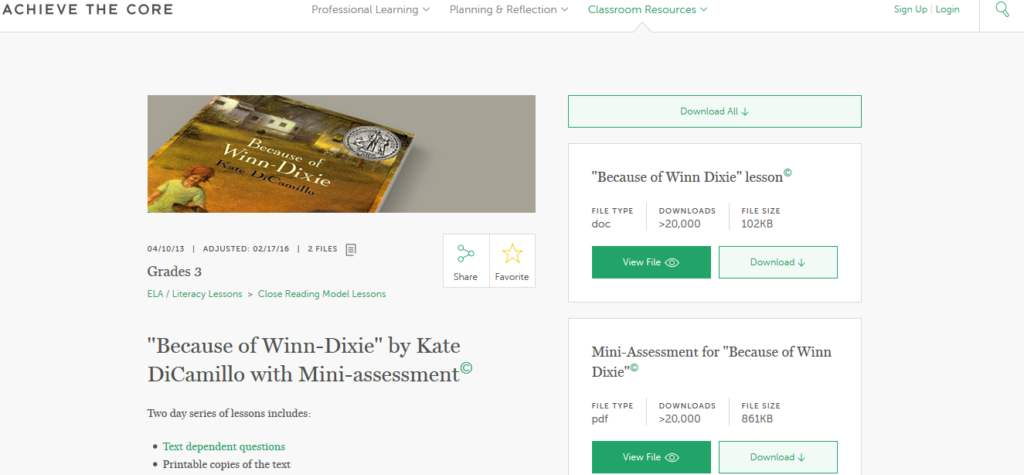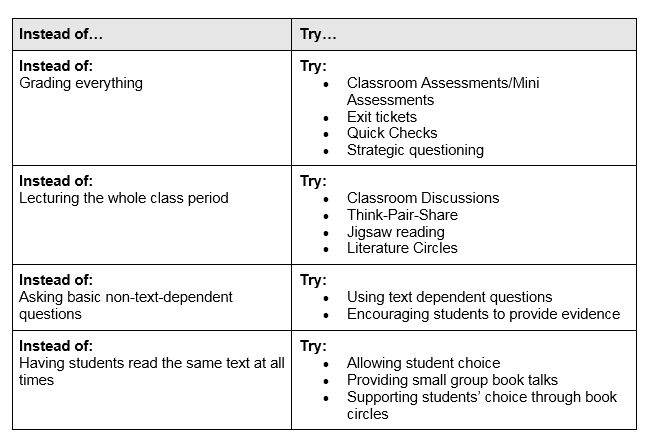Each year as I set up my ELA classroom, I always strive to arrange it so that it allows all students to be successful. As educators, we are continually exposed to new strategies and research to implement in our classrooms. Over the last few years, I have found several strategies that help me encourage my students to be successful within ELA standards.
Use Ungraded Classroom Assessment Strategies and Mini-Assessments
As a beginning teacher, I felt the urgency to grade everything my students submitted. I quickly became burned out and the assignments lost value when I had a stack a mile high to grade. I felt my students would only find benefit when an assessment was graded. I have since learned the value of varying the means by which I learn about my students’ progress. Through the use of exit tickets, quick checks, and strategic questions, I have learned more about my students’ continuing misconceptions, learning needs, and current progress toward mastery than I did through traditional graded assessments. Consider using Plickers as an digital, interactive way to conduct instant formative assessment as a class. Achieve the Core’s mini-assessments also serve in this capacity and allow my students to show their learning without its being attached to a grade at the top of their paper. The mini-assessments can be used in a “quick-check” capacity instead of a grade for the grade-book. I could then use them to inform my instruction rather than a grade.

Use Classroom Discussion to Support Collaboration
Students can often serve as the best teachers within our classrooms. It is our natural teacher tendency to use whole group lecture to ensure that all students hear the correct information regarding a specific topic or subject. However, at the end of the day, it leaves us exhausted and many times our students walk away not owning a concept. Incorporating classroom discussions can allow students to take ownership within the ELA classroom. Think-Pair-Share, Jigsaw reading, and literature circles allow students to share ideas and begin to form their own conceptual comprehension. Research indicates that students demonstrate greater understanding when they are able to teach a concept. Activities like Jigsaw reading (and other opportunities for students to use language to convey new information to one another) are especially helpful for English Language Learners. This technique can also be used in math (see Mathematical Language Routine 4 “Information Gap” on page 12 of this document). By providing opportunities for classroom discussion, you can foster a collaborative environment in your ELA classroom that allows students to build their learning.

Ask Text-dependent Questions to Deepen Understanding
When I used to work with my struggling readers, I tended to ask basic questions students could answer even if they hadn’t fully comprehended the text. I did this so they could feel successful, but I quickly learned that I was not helping learners grow as readers. Instead, I began to incorporate text-dependent questioning in my instruction. Although my less-prepared readers would need additional scaffolding, I saw their confidence grow and that they were able to access complex text successfully. Through the use of text-dependent questions, my students were able to use evidence to support their answers. As a result, readers gained a stronger understanding of the text.
Allow Student Choice
As a novice trying to manage my classroom, I felt that all my students needed to read the same text at all times. In that way, I could control our pace and how we progressed through the standards. Many of my students, though, would lose interest in what we were reading and I saw a huge lack of motivation with many of my readers. I became concerned that my students would lose their love for reading if I did not change my practice. By introducing student choice as a component of my literacy instruction, I still was able to manage the class’s pace as students progressed through the standards while encouraging reading motivation.

To everyone’s credit, I found more collaboration as book talks and reading circles developed around shared interests in my classroom. The greatest benefit came when my students felt empowered through their ability to have choice within our classroom.

















